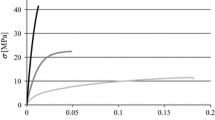Abstract
A mode-dependent embedded-process-zone (EPZ) model has been developed and used to simulate the mixed-mode fracture of plastically deforming adhesive joints. Mode-I and mode-II fracture parameters obtained from previous work have been combined with a mixed-mode failure criterion to provide quantitative predictions of the deformation and fracture of mixed-mode geometries. These numerical calculations have been shown to provide excellent quantitative predictions for two geometries that undergo large-scale plastic deformation: asymmetric T-peel specimens and single lap-shear joints. Details of the deformed shapes, loads, displacements and crack propagation have all been captured reasonably well by the calculations.
Similar content being viewed by others
References
Adams, R.D. and Wake, W.C. (1984). Structural Adhesive Joints in Engineering, Elsevier Applied Science Publisher, London.
Anderson, G.P., Brinton, S.H., Ninow, K.J. and DeVries, K.L. (1988). A fracture mechanics approach to predicting bond strength. In: Advances in Adhesively-Bonded Joints, ASME, New York, 93–101.
Bigwood, D.A. and Crocombe, A.D. (1990). Nonlinear adhesive bonded joint design analysis. International Journal of Adhesion and Adhesives 10, 31–41.
Bigwood, D.A. and Crocombe, A.D. (1992). Development of a full elasto-plastic adhesive joint design analysis. Journal of Strain Analysis 27, 211–218.
Chai, H. (1988). Shear fracture. International Journal of Fracture 37, 137–159.
Fernlund, G., Papini, M., McCammond, D. and Spelt, J.K. (1994). Fracture load predictions for adhesive joints. Composite Science and Technology 51, 587–600.
Goland, M. and Reissner, E. (1944). The stresses in cemented joints. Journal of Applied Mechanics 66, A17–A27.
Harris, J.A. and Adams, R.D. (1984). Strength prediction of bonded single lap joints by nonlinear finite element methods. International Journal of Adhesion and Adhesives 4, 65–78.
Hart-Smith, L.J. (1973). Adhesive-Bonded Single Lap Joints, Langley Research Center, NASA CR-112236, Hampton, Virginia.
Hart-Smith, L.J. (1981). Developments in Adhesives II. (Edited by Kinloch, A.J.), Applied Science Publisher, New York.
Hart-Smith, L.J. (1993). The bonded lap-shear test coupon – useful for quality assurance but dangerously misleading for design data. The 38th International SAMPE Symposium, 239–246.
Hutchinson, J.W. and Suo, Z. (1992). Mixed mode cracking in layered materials. Advances in Applied Mechanics 29, 63–191.
Lee, L.H. (1991). Adhesive Bonding, Plenum Press, New York.
Papini, M., Fernlund, G. and Spelt, J.K. (1994). The effect of geometry on the fracture of adhesive joints. International Journal of Adhesion and Adhesives 14, 5–13.
Tong, L. (1996). Bond strength for adhesive bonded single lap joints. Acta Mechanica 117, 103–113.
Tsai, M.Y., Oplinger, D.W. and Morton, J. (1998). Improved theoretical solutions for adhesive lap joints. International Journal of Solids and Structures 35, 1163–1185.
Tvergaard, V. and Hutchinson, J.W. (1993). The influence of plasticity on the mixed-mode interface toughness. Journal of the Mechanics and Physics of Solids 41, 1119–1135.
Tvergaard, V. and Hutchinson, J.W. (1996). On the toughness of ductile adhesive joints. Journal of the Mechanics and Physics of Solids 44, 789–800.
Wang, J.S. and Suo Z. (1990). Experimental determination of interfacial toughness using Brazil-nut-sandwich. Acta Metallurgica 38, 1279–1290.
Wei, Y. and Hutchinson, J.W. (1997). Nonlinear delamination mechanics for thin films. Journal of the Mechanics and Physics of Solids 45, 1137–1159.
Wei, Y. and Hutchinson, J.W. (1998). Interface strength, work of adhesion and plasticity in the peel test. International Journal of Fracture 93, 315–333.
Yang, Q.D., Thouless, M.D. and Ward, S.W. (1999). Numerical simulations of sdhesively-bonded beams failing with extensive plastic deformation. Journal of the Mechanics and Physics of Solids 47, 1337–1353.
Yang, Q.D., Thouless, M.D. and Ward, S.W. (2000a). Analysis of the symmetrical 90-peel test with extensive plastic deformation. Journal of Adhesion 72, 115–132.
Yang, Q.D., Thouless, M.D. and Ward, S.W. (2000b). Elastic-plastic mode-II fracture of adhesive joints. International Journal of Solids and Structures (in press).
Author information
Authors and Affiliations
Rights and permissions
About this article
Cite this article
Yang, Q., Thouless, M. Mixed-mode fracture analyses of plastically-deforming adhesive joints. International Journal of Fracture 110, 175–187 (2001). https://doi.org/10.1023/A:1010869706996
Issue Date:
DOI: https://doi.org/10.1023/A:1010869706996




